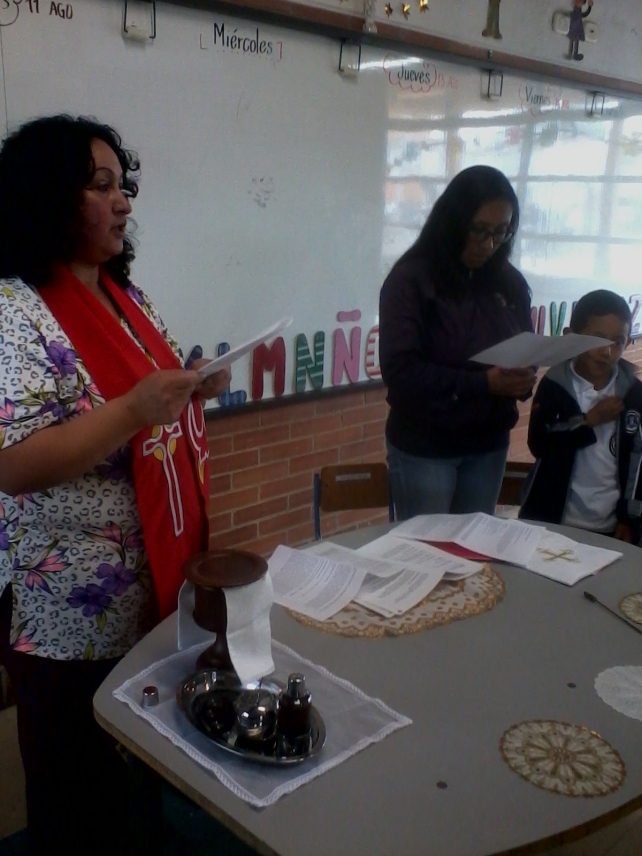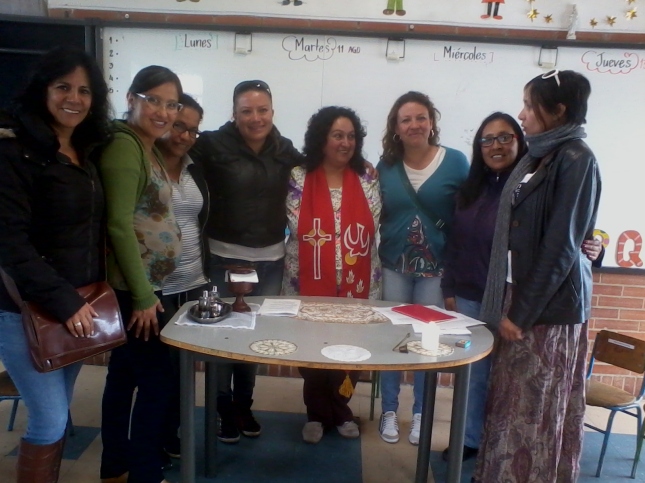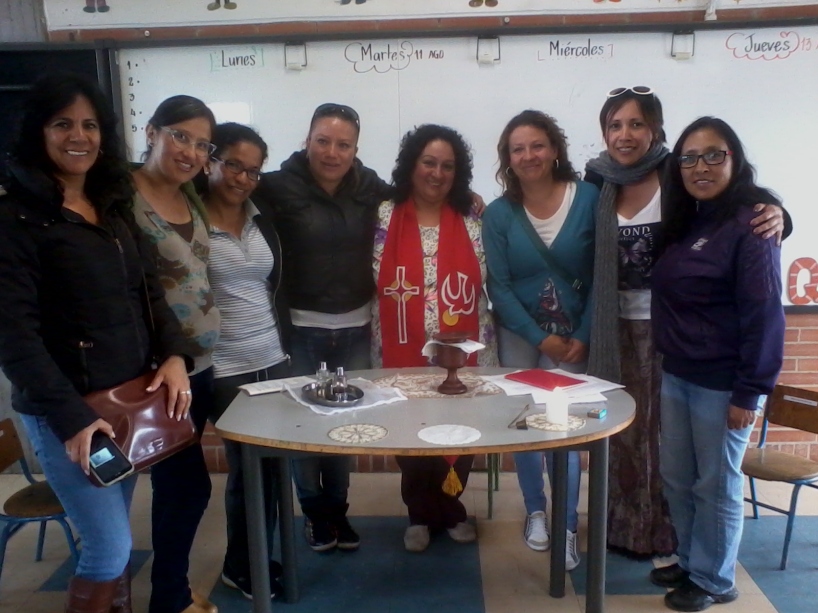Mary, Mother of Jesus Inclusive Catholic
Community
Interesting,
Inviting, Involving, Inspiring
Nineteenth Week in Ordinary Time
August 8, 2015
Lee Breyer, Kathryn Shea, co-presiders
Theme:
“...enough…get up and eat...bread of life.”
Greeting
and Gathering Hymn: “Song of the Body of Christ” #324, vs 1, 2, 3
Presider: Let
us pray as we come together to break the bread in the namess of God, our Creator
– and of Jesus, our Liberator - and of the Holy Spirit, our Sanctifier. All:
Amen.
Opening Prayer
All: God of life, truth and
compassion, you who directs all creation to its ultimate fulfillment in Jesus,
the Christ - open our hearts to the message of the Gospel so that your peace
may rule in our hearts and your justice guide our lives. Loving God, bless the hearts of all of us
gathered here now and all of those of our community who are not with us
today. We ask this in your name and
those of our Savior Jesus, and our Wisdom Sophia. Amen.
Penitential Rite and
Community Forgiveness
Presider: Loving God, we do not fully open our hearts
to your Spirit within us.
All: Help us to open ourselves
to Her message and be your voice among your people.
Presider: Christ Jesus, we do not really trust enough
in your promise that you would send your Spirit.
All: Help us to grow in our understanding and
confidence that your word brings peace.
Presider: Holy Spirit, pour out your healing grace and
supporting strength on us.
All: Help us to respond
to your presence in us and bring that blessing to your family.
All: (with an outstretched
arm): God, the Father and Mother of mercy, through Jesus’
life, death and resurrection, he bonded the world to you. He sent the Holy Spirit
among us to give us the wisdom to love you and the strength to love one
another. Loving God, teach us the virtues of pardon and peace so that we may –
in turn – learn to forgive each other our failures to care for one another and
for our planet Earth. We ask this in the
name of Jesus, our brother and of the Holy Spirit, our comforter. Amen.
Glory to God
All:
Glory to God in the highest, and peace to God’s people on earth. Heavenly God, Creator of the universe, we
thank you for the wonder of the Spirit at work in everything that exists,
everywhere in the cosmos. Through Jesus
Christ, you opened our minds so we could realize that you are always among us
and that we are able to experience you among our brothers and sisters. We ask you to receive our prayers, for you
are the Most High, with Jesus Christ and the Holy Spirit. Amen.
Liturgy of the Word
First
reading: 1 Kings19: 4 - 8 All: Thanks be to God.
Psalm 34: 2 –
9 Responsorial: “Taste and see….” #331
Second
reading: Paul’s letter to the Ephesians 4:30 – 5:2 All: Thanks
be to God.
Gospel: John 6: 41 - 51 All:
Glory and thanks to our Savior, Jesus the Christ.
Dialog
Homily/Community Reflection
Discussion starter:
How many times have we told ourselves “enough” and how many times have
we been told (in effect) “get up and eat”?
In those situations when we may feel like Elijah in the desert, how do
we understand Jesus’ claim to be more than the passing manna but, rather, is
the very bread of life that restores and supports us? Short version: how do we understand Jesus as
the bread of life, our life?
Profession of Faith
All: We believe in God, the Creator of
the universe whose divinity infuses all existence, making everything everywhere
sacred. We believe in Jesus, the Christ, who leads us
to the fullness of humanity. Through
him, we become new people, called beyond the consequences of our brokenness. We believe in the Holy Spirit, the Sustainer,
who keeps the Christ-vision present to all those who are searching for meaning
and wholeness in their lives – and the One who energizes us when our Spirits
may grow weary in our journey. We say: Amen
to courage, to hope, to the Spirit of truth.
Amen to wholeness, to the partnership and equality of all people of
different gender, race, and faith. We
believe in a world of justice and peace for everyone, everywhere, with no
exceptions. In all of this, we surely
believe.
Prayers
of the Community
Presider: We are a community of faith in our Creator and
compassion for our sisters and brothers. Then, mindful of God’s love and care
for us, we now bring our concerns and needs to our God.
All: After each intercession, respond: Loving God, hear our prayers.
Presider:
Healing God, we know that you faithfully listen to our prayers. We ask you to strengthen us in our caring for
one another and in our works for justice, equality, and peace.
Offertory
Procession and Hymn: “Gather Us In” #302
Preparation
of the Gifts
Presider: Blessed are you, O God. Through your goodness
we have this bread to offer,
the
grain from the earth and work of human hands. It will become for us the bread
of life.
All: Blessed be God forever.
Presider:
Blessed are you, O God. Through your
goodness we have this wine to offer,
the
fruit of the vine and work of human hands. It will become for us our Spiritual
drink.
All: Blessed be God forever.
Presider: In
this bread and wine, Jesus has promised to be present; through our sharing of
them, Christ will make us whole.
Gathering
of the Gifted:
All are welcome around our family table
ALL: Gracious God, we are united in
this sacrament by the love of Jesus Christ in communion with all those who
proclaim your power and mercy to the marginalized and oppressed peoples. Like
Mary, the first disciple, and all the saints through the centuries, may we live
as prophetic witnesses to the Gospel. We
ask this through Jesus, the Christ, Amen.
Presider: God dwells in each one of us. All: Namaste!.
Presider: Let us give thanks to the Creator and
Sustainer of all that exists.
All: With hearts full of love,
we give God thanks and praise.
Presider: Sacred Spirit, we recognize your presence
with us as we gather at our family table.
All: Fill us with reverence for you,
for one another, and for all your creation.
Presider: Let
us lift up our hearts.
All: We lift them up to the Holy
One, living in us and loving through us.
Eucharistic
Prayer
Voice 1:
Ever living and ever loving God, we do well always and everywhere to
give you thanks. In you we live and move
and have our being. Each day you show us
your love. Your Spirit dwelling in us
gives us the hope of unending peace and joy with you. And so, we sing with thankful praise:
All (sung): Holy, Holy, Holy God, God of power, God of
light. Heaven and earth are full of your
glory. Hosanna in the highest. Blessed are all who come in the name of our
God. Hosanna in the highest… Hosanna in
the highest.
Voice 2:
We thank you for the gift of Jesus in history and the gift of Jesus in
faith. Through him, you breathe life into us.
He revealed you to us in his life well lived. He showed us, through his example, not only
how we should live, but also for what we may even die.
Voice 3:
And when his time had come, Jesus suffered for what he deeply believed…his
conviction that love is stronger than death...and then, as an example for the
ages, he opened wide his arms and died.
The Spirit, who raised Jesus from the dead, is the foretaste and promise
of the paschal feast of heaven.
All:
O God, let your Spirit come upon these simple gifts that we have brought
from the fields to our table -- this wheat, gathered and grown and this wine,
fruit of the land. May She make them
holy, so that they may become for us the Body and Blood of Jesus, our brother.
(With an outstretched arm): We remember the gift that Jesus gave us on
the night before he died. He gathered
with his friends to share a final Passover meal. And it was at that supper that he took bread,
said the blessing, broke the bread and gave it to them saying: take this, all
of you,
and eat it. This bread is you; this bread is me. We are one body, the presence of God in the
world. Do this in memory of me. [Pause]
In the same way, he took a cup of wine,
said the blessing, and gave it to his friends saying: take this, all of you,
and drink it. This wine is you; this wine
is me. We are one blood, the presence of
God in the world. Do this in memory of
me.
Presider: Jesus,
who was with God “in the beginning of the creation of the heavens and the earth,”
is with us now in this bread. The Spirit,
of whom the prophets spoke in history, is with us now in this cup. Let us proclaim this mystery of faith.
All:
Christ has died. Christ is
risen. Christ lives in us and through us
in the world today.
Voice 4:
In memory of Jesus’ life, death and resurrection, we offer you, God,
this life-giving bread, this saving cup.
We thank you that we are in your presence and serve you. May all who share this sacred meal be brought
together in unity by the Holy Spirit.
And may that Spirit, that Wisdom, move freely in our lives as well as She
did in that of Jesus.
Voice 5:
God, remember your church throughout the world, help us grow in love,
together with Francis, our Pope, Bridget Mary, our Bishop, and all your family
everywhere - especially those who live on the margins of church and society.
Remember also all those people, living and dead, who touched our lives and left
their footprints on our hearts. We
remember especially….(mention names, if
you like).
All:
Through Christ, with Christ, and in Christ, in the unity of the Holy Spirit,
all glory and honor is yours, Our Creator God, forever and ever…. Amen (sung
several times)
All: Our Father and Mother, who are in
heaven, blessed is your name…..
The
Sign of Peace
Presider:
Jesus, you said to your disciples, “My peace I leave you; my peace I give
you.” Look on the faith of those
gathered here today and ….
All: Grant us your peace. By the example of Jesus and with the strength
of your Spirit, help us to spread that peace throughout the world, to everyone,
everywhere, no exceptions. Amen.
Presider: May
the peace of God be always with us, and let us start by offering a sign of that
peace to
one another.
Hymn:
“Let there be Peace on Earth” #532
Litany
for the Breaking of Bread
All:
Loving God, you call us to speak truth to power, have mercy on us. Loving God, you call us to Spirit-filled
service and to live the Gospel of peace and justice, have mercy on us. Loving God, you call us to be your presence
in the world and to be bearers of compassion everywhere in your name. Grant us peace.
Presider: This is Jesus, who liberates, heals, and
transforms us and our world. All are
invited to partake of this sacred banquet of love. All: We are the Body of Christ.
During-Communion
Hymn: We are holy; you are holy; I am
holy, we are holy. (3 times)
Post-Communion Period
Reflection: “Let Us Break Bread
Together” #334
Prayer
of Thanksgiving after Communion
Presider: Eternal God, may this Eucharist in which we always
share Christ’s healing love deepen our oneness with you and unity with one
another. We ask this in the name of Jesus, the Christ,
and the Spirit, the Wisdom. All:
Amen.
Community Prayers of
Gratitude
Closing
Prayer
All: May our hearts be glad on our
journey as we dream new dreams and see new visions.
May we all live and work for peace,
justice, and non-violence in our hearts for ourselves and our brothers and
sisters - whoever they are and wherever
they are.
May we learn to bless and honor and
hold in reverence the Earth and each other.
Amen.
Closing
Community Blessing
All: (with an outstretched
arm): May our nurturing God bless us gathered here
and all those in our communities – in the name of the Creator, in the name of Jesus
the Christ, and in the name of the Spirit, our Wisdom, as we minister to one
another as the people of God. Amen.
Closing
Hymn and Commissioning: “Take the Word of God
with you” #373
Presiders: As
we leave here in the peace of Christ, let our service continue in all that we
do.
All: Thanks be to God. Let it be so!










